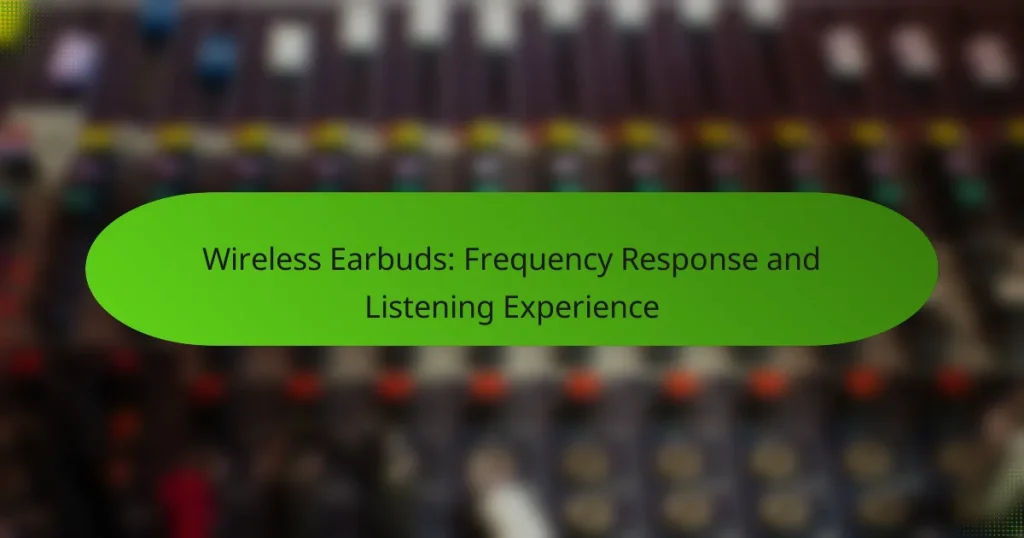Wireless earbuds have revolutionized the way we enjoy music and podcasts, but sound quality can vary significantly between models. Factors such as driver size, Bluetooth codec support, and noise cancellation technology play crucial roles in audio performance. By understanding these elements and choosing reputable brands like Sony, Apple, and Bose, you can enhance your listening experience and enjoy superior sound quality.
Wireless Earbuds: Driver Types, Sound Quality and Performance
Wireless Earbuds: Sound Quality, Evaluation and Performance
Wireless Earbuds: Frequency Response and Listening Experience
Wireless Earbuds: Noise Cancellation Impact and Sound Quality
Wireless Earbuds: Sound Quality for Gaming and Music
Wireless Earbuds: Superior Bass, Music Quality and Listening Enjoyment
How to improve wireless earbuds sound quality?
Improving wireless earbuds sound quality involves adjusting settings, using better audio sources, and keeping firmware updated. These steps can significantly enhance your listening experience by optimizing audio performance and compatibility.
Adjust equalizer settings
Equalizer settings allow you to tailor the sound profile of your wireless earbuds to match your preferences. Most devices and music apps offer built-in equalizers that let you boost or cut specific frequencies, such as bass or treble.
Experiment with different presets or create a custom setting that suits your music genre. For example, increasing bass can enhance hip-hop tracks, while boosting mids may benefit vocal-heavy music.
Use high-quality audio sources
To maximize sound quality, always use high-resolution audio files or streaming services that support lossless formats. Standard MP3 files may compress audio, leading to a loss of detail and clarity.
Consider services like Tidal or Qobuz that offer high-fidelity streaming options. If you download music, look for FLAC or WAV formats to ensure the best sound quality.
Upgrade firmware regularly
Firmware updates for your wireless earbuds can improve performance and sound quality by fixing bugs and enhancing features. Manufacturers often release updates that optimize audio processing and connectivity.
Check the manufacturer’s website or app regularly for available updates. Keeping your earbuds’ firmware current can lead to noticeable improvements in sound quality and battery life.
What factors affect sound quality in wireless earbuds?
Sound quality in wireless earbuds is influenced by several key factors, including driver size and type, Bluetooth codec support, and noise cancellation technology. Understanding these elements can help you choose earbuds that deliver the best audio experience.
Driver size and type
The driver is the component that converts electrical signals into sound. Generally, larger drivers can produce deeper bass and a fuller sound, while smaller drivers may excel in clarity and detail. Common driver types include dynamic, balanced armature, and planar magnetic, each offering different sound characteristics.
When selecting earbuds, consider the driver size; drivers typically range from 6mm to 15mm. For instance, earbuds with 10mm drivers often provide a balanced sound profile suitable for various music genres.
Bluetooth codec support
Bluetooth codecs determine how audio data is compressed and transmitted from your device to the earbuds. Popular codecs include SBC, AAC, aptX, and LDAC, each with varying levels of sound quality and latency. Higher-quality codecs like aptX and LDAC can significantly enhance audio fidelity, especially when streaming high-resolution music.
For optimal performance, ensure your earbuds support the same codec as your device. If you’re using an iPhone, for example, AAC support is crucial for the best sound experience.
Noise cancellation technology
Noise cancellation technology helps reduce ambient sounds, allowing for a more immersive listening experience. There are two main types: passive noise isolation, which physically blocks sound, and active noise cancellation (ANC), which uses microphones to counteract external noise. ANC can be particularly beneficial in noisy environments like public transport.
When choosing earbuds, consider how effective the noise cancellation is for your needs. Some models offer adjustable ANC settings, allowing you to customize the level of noise reduction based on your surroundings.
Which wireless earbuds offer the best sound quality?
The best wireless earbuds for sound quality typically include models from Sony, Apple, and Bose. These brands are renowned for their audio performance, noise cancellation features, and overall user experience.
Sony WF-1000XM4
The Sony WF-1000XM4 earbuds are widely praised for their exceptional sound quality and noise cancellation capabilities. They feature a custom-designed driver that delivers rich bass and clear highs, making them suitable for various music genres.
Additionally, the earbuds support high-resolution audio and come with adaptive sound control, which adjusts the noise cancellation based on your environment. Users can expect a battery life of around 8 hours on a single charge, with the case providing additional charges for a total of up to 32 hours.
Apple AirPods Pro
Apple AirPods Pro are known for their balanced sound profile and seamless integration with Apple devices. They offer active noise cancellation and a transparency mode, allowing users to switch between immersive listening and awareness of their surroundings.
The sound quality is enhanced by adaptive EQ, which automatically tunes the music to the shape of your ear. Battery life is approximately 4.5 hours with noise cancellation activated, and the charging case provides multiple additional charges, extending usage time significantly.
Bose QuietComfort Earbuds
Bose QuietComfort Earbuds excel in noise cancellation and sound quality, making them a top choice for audiophiles. They deliver a deep, immersive sound experience with a focus on clarity across all frequencies.
These earbuds feature adjustable noise cancellation levels, allowing users to customize their listening experience. With a battery life of about 6 hours per charge and an additional 12 hours from the charging case, they are designed for extended use without frequent recharging.
How do wireless earbuds compare to wired earbuds in sound quality?
Wireless earbuds generally provide convenience but may have some limitations in sound quality compared to wired earbuds. Factors such as latency, audio fidelity, and the technology used in wireless transmission can affect the overall listening experience.
Latency differences
Latency refers to the delay between audio playback and sound output, which can be more pronounced in wireless earbuds. While wired earbuds typically have negligible latency, wireless models can experience delays ranging from low tens of milliseconds to over 100 ms, depending on the Bluetooth version and codec used.
For activities like gaming or watching videos, lower latency is crucial. Look for earbuds that support aptX Low Latency or AAC codecs to minimize delays. Avoid older Bluetooth versions, as they may contribute to higher latency levels.
Audio fidelity variations
Audio fidelity in wireless earbuds can vary significantly based on the technology employed. Wired earbuds often deliver higher fidelity sound due to a direct connection, while wireless earbuds may compress audio, leading to potential quality loss. However, advancements in Bluetooth technology and codecs have improved sound quality in many modern wireless models.
When choosing wireless earbuds, consider those that support high-resolution audio codecs, such as LDAC or aptX HD, to enhance audio fidelity. Additionally, check for features like active noise cancellation, which can further improve the listening experience by reducing background noise.
What are the best practices for maintaining sound quality?
To maintain sound quality in wireless earbuds, regular cleaning and proper storage are essential. These practices help prevent buildup that can muffle sound and ensure longevity of the device.
Regular cleaning of earbuds
Cleaning your earbuds regularly is crucial for preserving sound quality. Earwax and debris can accumulate in the speaker mesh, leading to muffled audio. Aim to clean them every few weeks, or more often if you use them frequently.
Use a soft, dry cloth to wipe the exterior and a small brush or a cotton swab to gently clean the speaker mesh. Avoid using liquids, as they can damage the electronics. For deeper cleaning, refer to the manufacturer’s guidelines.
Proper storage and handling
Proper storage and handling of wireless earbuds can significantly impact their sound quality. Always store them in their charging case when not in use to protect them from dust and physical damage. Avoid placing them in pockets or bags where they can get scratched or tangled.
When handling your earbuds, avoid pulling on the wires or yanking them out of your ears, as this can damage the internal components. Additionally, be mindful of temperature extremes, as excessive heat or cold can affect battery performance and sound quality.
How does sound quality vary by brand?
Sound quality in wireless earbuds can significantly differ by brand due to variations in design, technology, and materials used. High-end brands often prioritize audio fidelity, while budget options may compromise on sound clarity and bass response.
Premium Brands
Premium brands like Sony, Bose, and Sennheiser typically offer superior sound quality, featuring advanced audio technologies such as noise cancellation and high-resolution audio support. These earbuds often deliver a balanced sound profile with rich bass and clear mids and highs, making them ideal for audiophiles.
When considering premium options, look for features like adaptive sound control and customizable equalizers that allow you to tailor the audio experience to your preferences. Expect to invest significantly, often ranging from $150 to $300 or more.
Mid-Range Brands
Mid-range brands such as Jabra and Anker provide a good balance between price and sound quality. These earbuds usually offer decent audio performance with satisfactory bass and clarity, making them suitable for casual listeners. Prices typically range from $70 to $150.
While they may lack some advanced features found in premium models, many mid-range earbuds still include essential functionalities like water resistance and decent battery life. It’s advisable to check user reviews to gauge sound quality before purchasing.
Budget Brands
Budget brands like TaoTronics and Mpow often prioritize affordability, which can lead to compromised sound quality. While these earbuds can be suitable for basic listening needs, they may lack depth in bass and clarity in vocals, typically priced under $70.
When opting for budget earbuds, focus on user reviews and sound tests to ensure they meet your expectations. Look for models that offer good battery life and comfort, as these factors can enhance your overall listening experience despite lower sound quality.






